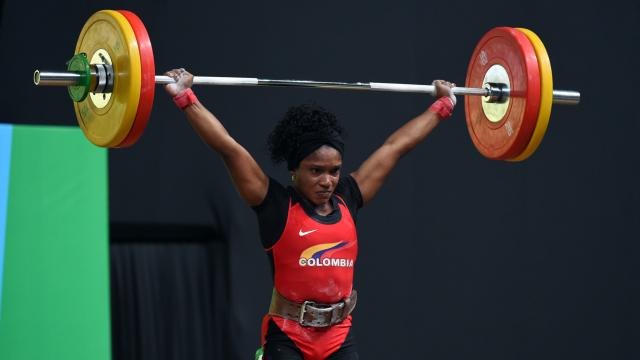The first time I lifted at a gym where the weights are in kilos, my well-honed plate maths skills became suddenly useless. The numbers were all different, the plates were funny colours, and yet, before long, I discovered I kinda liked it that way.
If you’re checking out a new gym, moving countries, or switching sports to one that’s more fancy and international, here’s what you’ll need to know.
Know the rule of thumb to convert
First off, what is a kilo? It’s an amount of mass (not weight) roughly equal to that of a litre of water. It used to be technically defined as the mass of a certain chunk of metal in France; now it’s something about Planck’s constant. But none of that is important right now. In Earth’s gravity, it’s equivalent to about 1 kg.
Sounds too annoying to do in your head? Think again. To convert kilos to pounds, just double the number and then add 10%. Like so:
- 10 kilograms = 22 pounds
- 20 kg = 44 lbs
- 30 kg = 66 lbs
- 40 kg = 88 lbs
- 50 kg = 110 lbs
That’s kind of beautiful. How does it hold up with bigger numbers?
- 80 kg = 176 lbs (160 + 16, get it?)
- 100 kg = 220 lbs
- 150 kg = 330 lbs
- 200 kg = 440 lbs
You get the idea. Just remember that a kilo is bigger than a pound, so kilo numbers tend to be small, and pound numbers tend to be big. Happy you lifted 100 pounds? Great, but that’s only 45 kilos.
Anyway, if all else fails, get out your calculator and multiply or divide by 2.2.
Or for another rule of thumb, if you’re used to multiplying in 45’s (because a power bar is 45 pounds and the big pound plates are 45 pounds), just know that 45 pounds is roughly 20 kilos.
…But don’t switch back and forth during a workout
Those rules of thumb are fine for when you have to convert, but as you’re doing your workouts, don’t try to calculate every single lift in your head.
Especially if you’re going to be training in kilos for the foreseeable future, you should just learn to think in kilos. Same as if you were learning a foreign language: it pays to be able to come up with the right words without running to the dictionary every time.
When I started olympic weightlifting, the lifts were as new to me as the system of units. So it was kind of like playing with Monopoly money: these numbers mean something in the gym, but it doesn’t much matter what they mean outside of it. I could snatch 35 kilos within a few weeks of starting. How many pounds is 35 kilos? Who cares? We speak kilos here now.
Eventually you may need to convert back and forth, but for your everyday workouts, stick to one set of units. One thing to remember, though: if you’re used to working up in weight by adding 10 pounds at a time, don’t add 10 kilos and think you’re making a similar jump. Five kilos would be more like what you’re looking for. (5 kg = 11 lbs.)
Learn the colours
Pound plates are often black or plain iron, but kilo plates — particularly bumper plates, the kind you’ll find in olympic weightlifting gyms — follow a standard colour coding:
- red is 25 kilos
- blue is 20
- yellow is 15
- green is 10
- white is 5
If there are smaller coloured plates, they are each 1/10 the weight of their larger cousins:
- little reds are 2.5
- little blues are 2
- little yellows are 1.5
- little greens are 1
- little whites are 0.5
The white 5-kilo plates are usually smaller than the full size plates, but you won’t confuse them with the 0.5’s, which are teeny tiny.
Many gyms have full-size versions of the 5-kilo and 2.5-kilo plates, which will appear as large sized reds and whites. You’ll know the difference between 25-kilo “big reds” and the 2.5 kilo ones because the one is monstrously heavy and the other feels like a toy. Also, they are labeled.
(This can lead to some hilarious Insta videos if the label is hidden from the camera—I recall one with a woman curling a bar that had, I believe, four red plates on a side. That would be something like 40 kilos, not 220.)
Learn to recognise what you see on the bar
Because the colour-coded plates are standard, you’ll quickly learn to recognise how much weight is on the bar based on what colours you can see. When I lift with a 15-kilo women’s bar, I know that if I put on a pair of greens I’m lifting 35; yellows, 45; blues, 55; and big reds, 65.
On a 20-kilo bar, greens make 40, yellows make 50, blues 60, and big reds 70.
Two red plates is 110 kilos on a 20-kilo bar, or 105 on a women’s bar. (In olympic weightlifting, women use a thinner bar because it flexes more at lighter weights and is easier for smaller hands to grip. In other strength sports, including powerlifting, everyone uses the same bar.)
If you’re watching a weightlifting or powerlifting competition, remember that competition collars add 2.5 kilos per side, or 5 kg total. (In the gym most of us go without collars or use small ones that aren’t worth counting.)
Once you get the hang of it, counting in kilos is no harder than counting in pounds — and in fact, you may find it easier. In the meantime, if you’re having trouble, consider printing out this kilos-to-pounds chart and pasting it into your training journal.

Leave a Reply
You must be logged in to post a comment.